Rubidium atoms are used to convert between millimetre-wave photons and optical-wavelength photons.
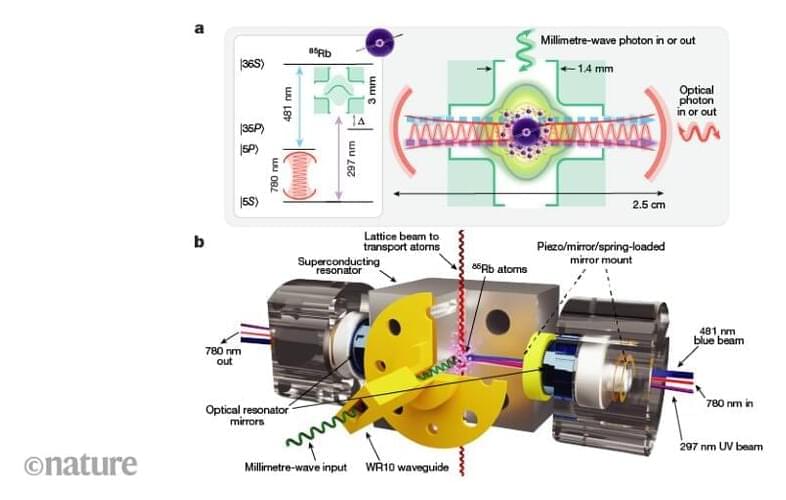

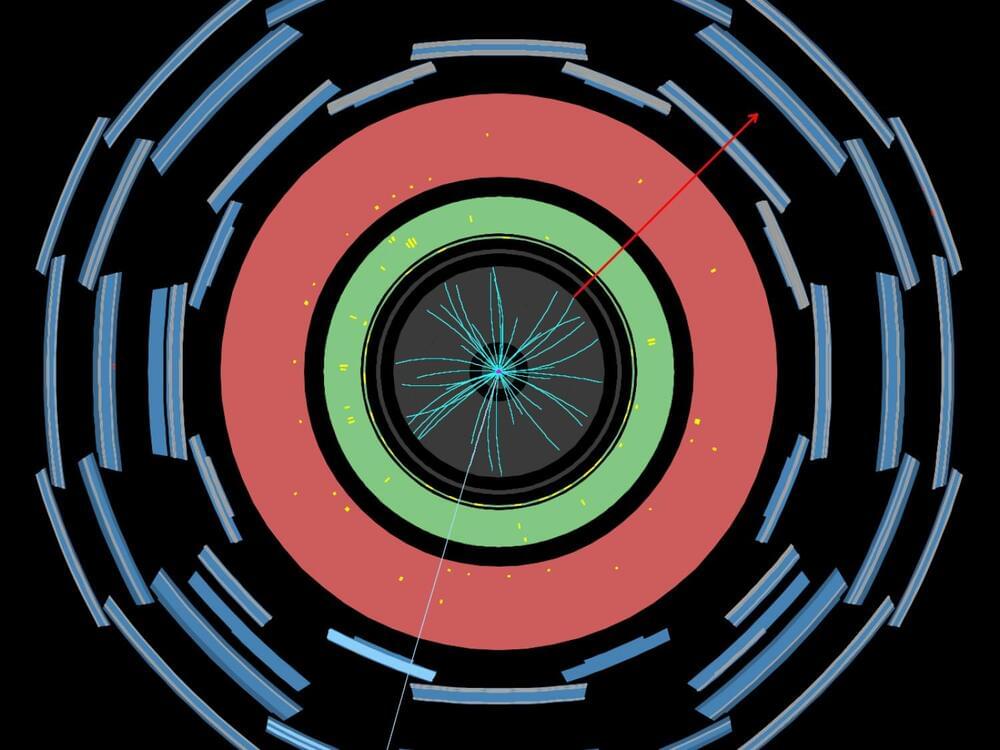
For the past 40 years, the W boson has been making headlines. In the 1980s, the announcement of its discovery helped confirm the theory of the electroweak interaction – a unified description of electromagnetic and weak forces. Today, measurements of its mass (mW) are testing the consistency of the Standard Model it helped to form. Figure 1: The measured value of the W-boson mass is compared to other published results. The vertical bands show the Standard Model prediction, and the horizontal bands and lines show the statistical and total uncertainties of the published results. (Image: ATLAS Collaboration/CERN) The W-boson mass is closely related to the masses of nature’s heaviest particles, including the top quark and the Higgs boson. However, if additional heavy particles exist, the mass might deviate from the Standard Model prediction. By comparing direct measurements of the W-boson mass to theoretical calculations, physicists are looking for deviations that could be an indicator of new phenomena. To be sufficiently sensitive to such deviations, mass measurements need to have amazingly small uncertainties, of the order of 0.01%. In 2017, the ATLAS Collaboration at CERN published the LHC’s first measurement of the W-boson mass, giving a value of 80,370 MeV with an uncertainty of 19 MeV. At the time, this measurement was the most precise single-experiment result, and was in agreement with the Standard Model prediction and all other experimental results. Last year, the CDF Collaboration at Fermilab published an even more precise measurement of the W-boson mass, analysing the full dataset provided by the Tevatron collider. With a value of 80,434 MeV and an uncertainty of 9 MeV it differed significantly from the Standard Model prediction and from the other experimental results. In a new preliminary result released today, the ATLAS Collaboration reports an improved re-analysis of its initial W-boson mass measurement. ATLAS finds mW to be 80,360 MeV, with an uncertainty of just 16 MeV. The measured value is 10 MeV lower than the previous ATLAS result and is in agreement with the Standard Model. The ATLAS Collaboration has measured the W boson mass to be 80,360 MeV with an uncertainty of 16 MeV – in agreement with the Standard Model. Figure 2: The 68% and 95% confidence-level contours of the indirect determination of the W-boson and top-quark mass from the global electroweak fit are compared to the 68% and 95% confidence-level contours of the ATLAS measurements of the W-boson and top-quark masses. (Image: ATLAS Collaboration/CERN) For this new analysis, ATLAS physicists revisited its data collected in 2011 at a centre-of-mass energy of 7 TeV (corresponding to 4.6 fb-1, also used in ATLAS’ previous measurement). Researchers employed improved statistical methods and refinements in the treatment of the data, enabling them to reduce the uncertainty of their mass measurement by more than 15%. Researchers focused on collision events where the W boson decays into an electron or a muon (leptons), and a corresponding neutrino. The W-boson mass was then determined by fitting the kinematic distributions of the decay leptons in simulation to the data. The main difference between the 2017 and the new measurement is in the method used to perform these fits. While the previous measurement used the available data solely to determine the W-boson mass, with systematic uncertainties added after the fact, the new measurement simultaneously adjusts the systematic uncertainties together with the W-boson mass. This improvement reduced several systematic uncertainties, particularly those related to the theoretical modelling of W-boson production and decay. The W-boson transverse momentum distribution has as much of an influence on the lepton-decay distributions as the W-boson mass itself – and is therefore an important source of uncertainty. As the resolution of the 2011 data was too poor to verify the modelling of this distribution in detail, researchers instead used data recorded in 2017 during a special, low-luminosity proton-proton run at a centre-of-mass energy of 5 TeV. They found the data agreed with predicted distributions, thus validating the model. Also crucial to the measurement were the parton distribution functions (PDFs) of the proton, which model the relative momenta of its quark and gluon constituents. PDFs incorporate a multitude of data from different particle physics experiments. Since the previous measurement, these sets have been refined by including more data. The new ATLAS measurement evaluated the dependence of the measured W-boson mass on PDFs sets considering these more recent versions. Future measurements of the W-boson mass are expected by other LHC experiments, as well as further studies by ATLAS using data samples recorded in different pile-up conditions and at different centre-of-mass energies. These will provide independent evaluations of the experimental results obtained so far. About the event display in the banner: Display of a candidate W→μν event using proton-proton collisions at 7 TeV centre-of-mass energy at the LHC. Starting from the centre of the ATLAS detector, the reconstructed tracks of the charged particles in the Inner Detector (ID) are shown as cyan lines. The energy deposits in the electromagnetic (the green layer) and hadronic (the red layer) calorimeters are shown as yellow boxes. The identified muon is shown with its reconstructed track (blue line) passing through the muon chambers (blue layers). The muon has a transverse momentum of pT=36 GeV, whereas the missing transverse energy (red arrow) is 35 GeV and corresponds to the muon neutrino energy. The transverse mass of the W boson candidate is 71 GeV. (Image: ATLAS Collaboration/CERN) Explore the interactive event display Dynamic view of a candidate W→μν event using proton-proton collisions at 7 TeV centre-of-mass energy at the LHC. Starting from the centre of the ATLAS detector, the reconstructed tracks of the charged particles in the Inner Detector (ID) are shown as red lines. The energy deposits in the calorimeters are shown as yellow boxes. The identified muon is shown as a longer red dashed line. The missing transverse momentum is shown by a green dashed line. Learn more Improved W boson Mass Measurement using 7 TeV Proton-Proton Collisions with the ATLAS Detector (ATLAS-CONF-2023–004) Improved ATLAS result weighs in on the W boson, CERN Press Release, March 2023 Moriond EW 2023 presentation by Matthias Schott: EWK highlights from ATLAS High-precision measurement of the W boson mass with the CDF II detector (Science, Vol 376, Issue 6589) Briefing to previous W boson mass measurement, Physics Briefing, December 2016 First high-precision measurement of the mass of the W boson at the LHC, CERN Press Release, February 2018.
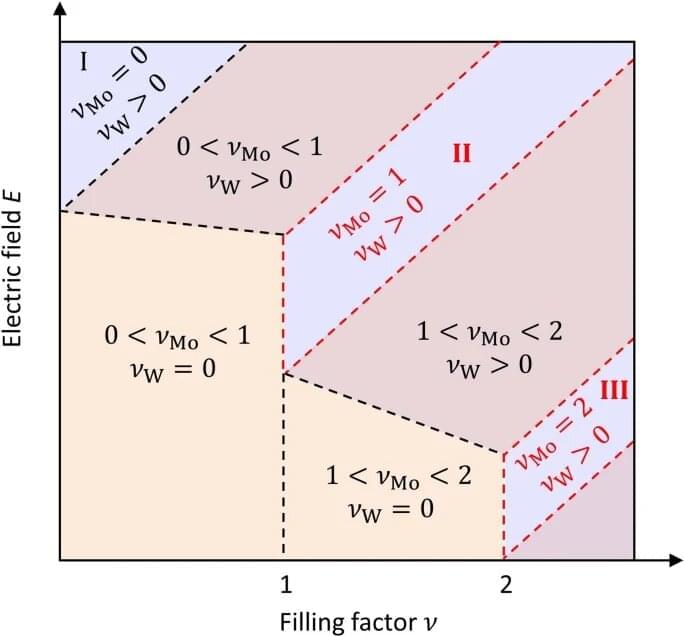
A model system created by stacking a pair of monolayer semiconductors is giving physicists a simpler way to study confounding quantum behavior, from heavy fermions to exotic quantum phase transitions.
The group’s paper, “Gate-Tunable Heavy Fermions in a Moiré Kondo Lattice,” published March 15 in Nature. The lead author is postdoctoral fellow Wenjin Zhao in the Kavli Institute at Cornell.
The project was led by Kin Fai Mak, professor of physics in the College of Arts and Sciences, and Jie Shan, professor of applied and engineering physics in Cornell Engineering and in A&S, the paper’s co-senior authors. Both researchers are members of the Kavli Institute; they came to Cornell through the provost’s Nanoscale Science and Microsystems Engineering (NEXT Nano) initiative.
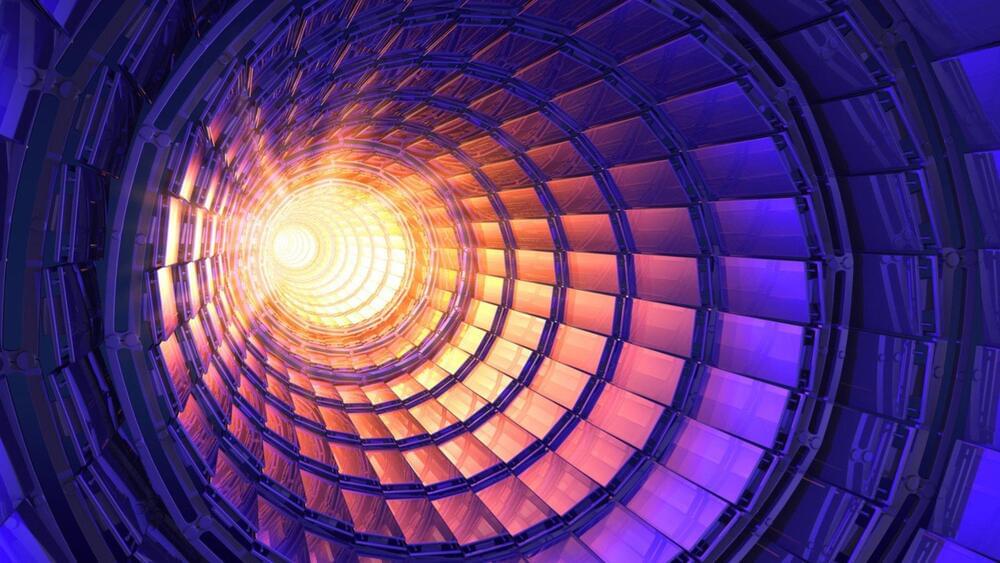
Neutrinos created by LHC went undetected earlier, but FASER changed that and can help us learn more about deep space.
Researchers at the European Organization for Nuclear Research, commonly known as CERN, have detected neutrinos created by the Large Hadron Collider (LHC) experiment for the very first time. These were the highest energy neutrinos that were ever produced in a laboratory setup and are similar to those found in particle showers from deep space.
First detected in 1956, neutrinos are subatomic particles that play a key role in the burning of stars. Every time nuclei of atoms either come together (fusion) or break apart (fission) in the universe, neutrinos are released.
-Dant-/iStock.
One of the most abundant particles of the cosmos, neutrinos play an important role in the standard model of particle physics too. Researchers have been creating neutrinos in the lab to study but never have they been detected by the giant laboratory of the LHC.

The province, however, is seeking a solution to its future relevance taking baby steps of which CFGC is one. Having said this, it still is an important initiative that could have enormous Canada-wide impacts.
What is carbon fibre?
Carbon fibre is less than a tenth the thickness of human hair. It contains carbon atoms almost exclusively. It is lightweight yet strong and can be bundled with other carbon fibres, woven, pressed and moulded. Carbon fibre material can be turned into tubes for bicycles, tennis rackets, and golf clubs. As a sheet, it can be moulded and turned into body parts for automobiles and trucks. Today, it is in the wings of modern aircraft replacing aluminum and steel. It is in Rocket Lab’s Electron rocket. And in construction, it can be used instead of concrete, brick, wood, and even steel.

Australian scientists have recreated a famous experiment and confirmed quantum physics’s bizarre predictions about the nature of reality, by proving that reality doesn’t actually exist until we measure it — at least, not on the very small scale.
That all sounds a little mind-meltingly complex, but the experiment poses a pretty simple question: if you have an object that can either act like a particle or a wave, at what point does that object ‘decide’?
Our general logic would assume that the object is either wave-like or particle-like by its very nature, and our measurements will have nothing to do with the answer. But quantum theory predicts that the result all depends on how the object is measured at the end of its journey. And that’s exactly what a team from the Australian National University has now found.
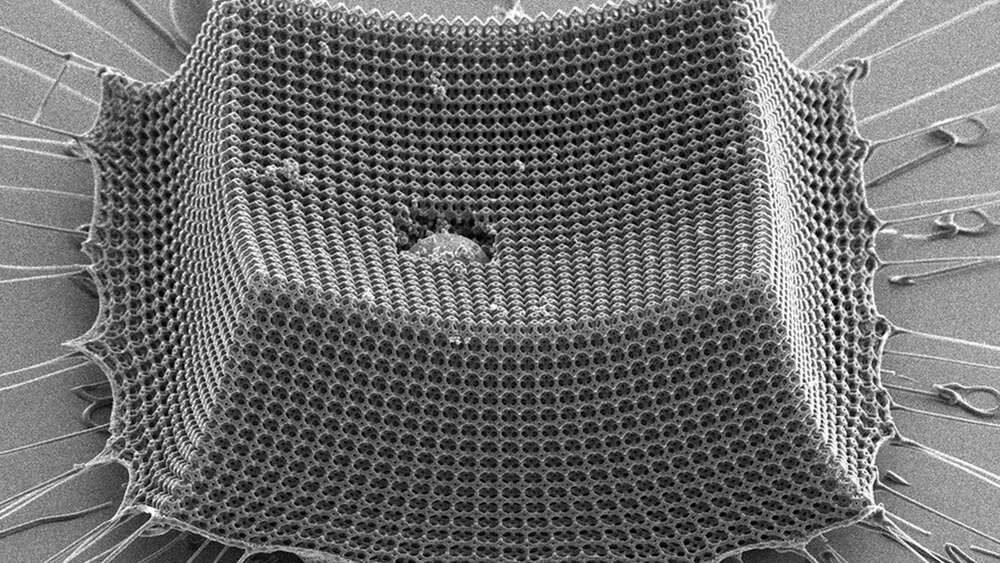
A joint research project’s findings have just been published in the journal Nature Materials from engineers from MIT, Caltech, and ETH Zurich that has yielded a “nano-architectured” material that could prove stronger than Kevlar and steel. This material, once scaled, could provide a means of developed lightweight, protective coverings, blast shields, and other impact-resistance materials and armors for various industries.
The material is less than a width of a human hair, but still able to prevent the tiny, high-speed particles from penetrating it. According to the researchers behind the project, when compared with steel Kevlar, aluminum rother impact-resistant materials of comparable weight, the new nanotech armor outperforms them all.
A biological method that produces metal nanoclusters using the electroactive bacterium Geobacter sulfurreducens could provide a cheap and sustainable solution to high-performance catalyst synthesis for various applications such as water splitting.
Metal nanoclusters contain fewer than one hundred atoms and are much smaller than nanoparticles. They have unique electronic properties but also feature numerous active sites available for catalysis on their surface. There are several synthetic methods for making metal nanoclusters, but most require multiple steps involving toxic substances and harsh temperature and pressure conditions.
Biological methods are expected to deliver ecofriendly alternatives to conventional chemical synthesis. Yet, to date, they have only led to large nanoparticles in a wide range of sizes. “We found a way to control the size of the nanoclusters,” says Rodrigo Jimenez-Sandoval, a Ph.D. candidate in Pascal Saikaly’s group at KAUST.

In recent years, a group of Hungarian researchers have made headlines with a bold claim. They say they’ve discovered a new particle — dubbed X17 — that requires the existence of a fifth force of nature.
The researchers weren’t looking for the new particle, though. Instead, it popped up as an anomaly in their detector back in 2015 while they were searching for signs of dark matter. The oddity didn’t draw much attention at first. But eventually, a group of prominent particle physicists working at the University of California, Irvine, took a closer look and suggested that the Hungarians had stumbled onto a new type of particle — one that implies an entirely new force of nature.
Then, in late 2019, the Hungarian find hit the mainstream — including a story featured prominently on CNN — when they released new results suggesting that their signal hadn’t gone away. The anomaly persisted even after they changed the parameters of their experiment. They’ve now seen it pop up in the same way hundreds of times.
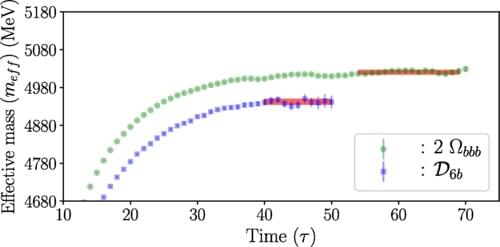
Dibaryons are the subatomic particles made of two baryons. Their formations through baryon-baryon interactions play a fundamental role in big-bang nucleosynthesis, in nuclear reactions including those within stellar environments, and provide a connection between nuclear physics, cosmology and astrophysics.
Interestingly, the strong force, which is the key to the existence of nuclei and provides most of their masses, allows formations of numerous other dibaryons with various combinations of quarks. However, we do not observe them abound—deuteron is the only known stable dibaryon.
To resolve this apparent dichotomy, it is essential to investigate dibaryons and baryon-baryon interactions at the fundamental level of strong interactions. In a recent publication in Physical Review Letters, physicists from the Tata Institute of Fundamental Research (TIFR) and The Institute of Mathematical Science (IMSc) have provided strong evidence for the existence of a deeply bound dibaryon, entirely built from bottom (beauty) quarks.